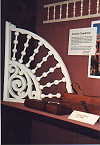Victorian
Gingerbread

The "gingerbread" trim
used on Victorian houses was highly complex and ornate, and would have been
extremely time-consuming for carpenters to make. Therefore, the vast majority
of this sort of trim was purchased from manufacturers who mass-produced the
goods on power-driven mills.
If a carpenter were to make the trim,
he would have used a variety of cutting, shaping and smoothing tools. These
might have included the following:
Bow Saw
The bow saw is used to cut out all
manner of woodwork. The blades range from 6" to 36" in length and
from 1/8" or less to 1" or more in width. To keep the thin blade taut and prevent
it from buckling during cutting, the frame is designed to tension the blade
with a twist-tightened string (some saws used a threaded rod and wing nut).
A stick called a toggle threaded between the bowstring strands gave the user
leverage for tightening the string. The blades are typically held in place by
slotted fittings on the ends of the handles that allow the user to rotate the
blade during cutting, so tricky curvaceous patterns can be cut without having
to do a jig-step around the workpiece.
A simple type of bow saw, the coping
saw, is used for small trim work on moldings and other fine curves.
Other Saws
Other saws used for cutting curves
include the compass saw and the keyhole saw.
Combination Plane
These versatile tools consist of
a plane and an array of interchangeable irons. The earliest wooden combination
planes date from the 16th century; cast-iron ones appeared in the last half
of the 19th century. They would have been very useful for the large variety
of trims on a Victorian house.
Compass (Circular)
Planes
Used for shaping curved work, compass
planes look like coffin-shaped smoothing planes with a sweeping convex sole.
Draw Knives
 Among the most effective tools were
drawknives which often had two handles, allowing the carpenter to use both hands
in drawing the knife toward himself when shaving wood. Plow planes and spoke
shaves were used on rough edges, although originally, spoke shaves were used
to shape wooden buggy wheels.
Among the most effective tools were
drawknives which often had two handles, allowing the carpenter to use both hands
in drawing the knife toward himself when shaving wood. Plow planes and spoke
shaves were used on rough edges, although originally, spoke shaves were used
to shape wooden buggy wheels.
Drawknives came in many sizes and shapes depending upon their purpose, but they all have the two handles in common as a design feature.
| Home
| Exhibit
Guide |
 |
This
page last updated:
August 5, 2002
Original content: Copyright © 2000, 2001 Museum of American Heritage
|
 Among the most effective tools were
drawknives which often had two handles, allowing the carpenter to use both hands
in drawing the knife toward himself when shaving wood. Plow planes and spoke
shaves were used on rough edges, although originally, spoke shaves were used
to shape wooden buggy wheels.
Among the most effective tools were
drawknives which often had two handles, allowing the carpenter to use both hands
in drawing the knife toward himself when shaving wood. Plow planes and spoke
shaves were used on rough edges, although originally, spoke shaves were used
to shape wooden buggy wheels. 
